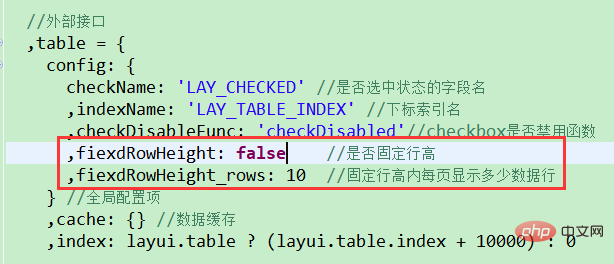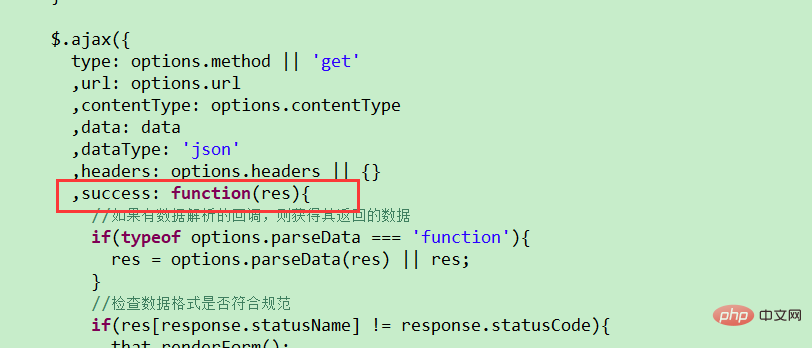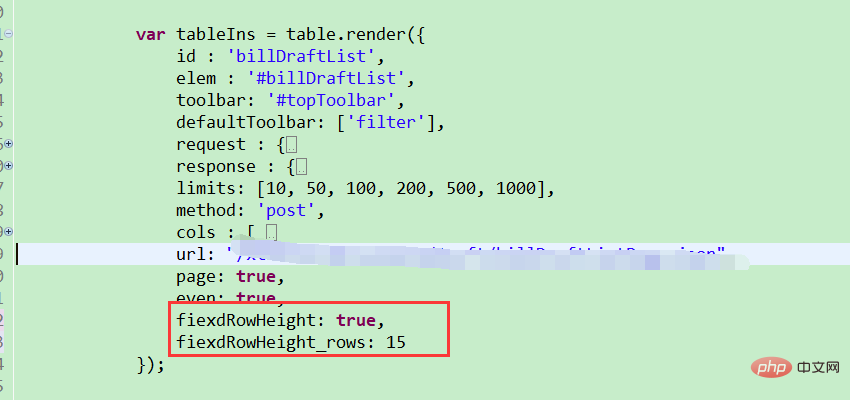How to fix the header of the table in layui
How to fix the table header in layui: first find the table.js file in layui; then add the fiexdRowHeight attribute to the variable table; finally add the code "if(Object.prototype.toString.call(.. .))" will do.

Recommended: "layUI Tutorial"
Achievement effect: The header and bottom pagination are fixed, and the mouse scrolling will only Scroll the data in the body. The effect is as follows:

1. Find the table.js file in layui and add attributes to the variable table, as shown in the red box: 
fiexdRowHeight: Whether to enable fixed row height, the default is false
fiexdRowHeight_rows: The number of rows displayed in the table, the default is 10
Both of the above two parameters can be passed in by themselves
2. Find the pullData function:


In this function, add the last one in the success function of the ajax asynchronous request success callback The following code:
//固定行高、表头处理
if(Object.prototype.toString.call(options.fiexdRowHeight).slice(8, -1) === 'Boolean' && options.fiexdRowHeight) {
var p_ = $("[lay-id='" + options.id + "']")
var tr_len = p_.find(ELEM_MAIN).find("tr").length
if(tr_len > 10){
if(Object.prototype.toString.call(options.fiexdRowHeight_rows).slice(8, -1) !== 'Number') {
options.fiexdRowHeight_rows = 10
}
var height_main = (options.fiexdRowHeight_rows * 39) + 'px'
var height_fixed = (options.fiexdRowHeight_rows * 39) + 'px'
//如果出现横向滚动条时
if(p_[0].parentNode.clientWidth < document.getElementsByClassName('layui-table-main')[0].getElementsByClassName('layui-table')[0].clientWidth) {
height_main = ((options.fiexdRowHeight_rows * 39) + 18) + 'px'
}
p_.find(ELEM_MAIN).css("height", height_main);
p_.find(ELEM_FIXL).find(ELEM_BODY).css("height", height_fixed);
p_.find(ELEM_FIXR).find(ELEM_BODY).css("height", height_fixed);
}else {
p_.find(ELEM_MAIN).css("height", "auto");
p_.find(ELEM_FIXL).find(ELEM_BODY).css("height", "auto");
p_.find(ELEM_FIXR).find(ELEM_BODY).css("height", "auto");
}
}3. Application: As shown in the figure:

The above is the detailed content of How to fix the header of the table in layui. For more information, please follow other related articles on the PHP Chinese website!

Hot AI Tools

Undresser.AI Undress
AI-powered app for creating realistic nude photos

AI Clothes Remover
Online AI tool for removing clothes from photos.

Undress AI Tool
Undress images for free

Clothoff.io
AI clothes remover

AI Hentai Generator
Generate AI Hentai for free.

Hot Article

Hot Tools

Notepad++7.3.1
Easy-to-use and free code editor

SublimeText3 Chinese version
Chinese version, very easy to use

Zend Studio 13.0.1
Powerful PHP integrated development environment

Dreamweaver CS6
Visual web development tools

SublimeText3 Mac version
God-level code editing software (SublimeText3)

Hot Topics
 1378
1378
 52
52
 How to set up jump on layui login page
Apr 04, 2024 am 03:12 AM
How to set up jump on layui login page
Apr 04, 2024 am 03:12 AM
Layui login page jump setting steps: Add jump code: Add judgment in the login form submit button click event, and jump to the specified page through window.location.href after successful login. Modify the form configuration: add a hidden input field to the form element of lay-filter="login", with the name "redirect" and the value being the target page address.
 How to get form data in layui
Apr 04, 2024 am 03:39 AM
How to get form data in layui
Apr 04, 2024 am 03:39 AM
layui provides a variety of methods for obtaining form data, including directly obtaining all field data of the form, obtaining the value of a single form element, using the formAPI.getVal() method to obtain the specified field value, serializing the form data and using it as an AJAX request parameter, and listening Form submission event gets data.
 How layui implements self-adaptation
Apr 26, 2024 am 03:00 AM
How layui implements self-adaptation
Apr 26, 2024 am 03:00 AM
Adaptive layout can be achieved by using the responsive layout function of the layui framework. The steps include: referencing the layui framework. Define an adaptive layout container and set the layui-container class. Use responsive breakpoints (xs/sm/md/lg) to hide elements under specific breakpoints. Specify element width using the grid system (layui-col-). Create spacing via offset (layui-offset-). Use responsive utilities (layui-invisible/show/block/inline) to control the visibility of elements and how they appear.
 How to transfer data in layui
Apr 26, 2024 am 03:39 AM
How to transfer data in layui
Apr 26, 2024 am 03:39 AM
The method of using layui to transmit data is as follows: Use Ajax: Create the request object, set the request parameters (URL, method, data), and process the response. Use built-in methods: Simplify data transfer using built-in methods such as $.post, $.get, $.postJSON, or $.getJSON.
 Simple JavaScript Tutorial: How to Get HTTP Status Code
Jan 05, 2024 pm 06:08 PM
Simple JavaScript Tutorial: How to Get HTTP Status Code
Jan 05, 2024 pm 06:08 PM
JavaScript tutorial: How to get HTTP status code, specific code examples are required. Preface: In web development, data interaction with the server is often involved. When communicating with the server, we often need to obtain the returned HTTP status code to determine whether the operation is successful, and perform corresponding processing based on different status codes. This article will teach you how to use JavaScript to obtain HTTP status codes and provide some practical code examples. Using XMLHttpRequest
 What is the difference between layui and vue?
Apr 04, 2024 am 03:54 AM
What is the difference between layui and vue?
Apr 04, 2024 am 03:54 AM
The difference between layui and Vue is mainly reflected in functions and concerns. Layui focuses on rapid development of UI elements and provides prefabricated components to simplify page construction; Vue is a full-stack framework that focuses on data binding, component development and state management, and is more suitable for building complex applications. Layui is easy to learn and suitable for quickly building pages; Vue has a steep learning curve but helps build scalable and easy-to-maintain applications. Depending on the project needs and developer skill level, the appropriate framework can be selected.
 How to run layui
Apr 04, 2024 am 03:42 AM
How to run layui
Apr 04, 2024 am 03:42 AM
To run layui, perform the following steps: 1. Import layui script; 2. Initialize layui; 3. Use layui components; 4. Import layui styles (optional); 5. Ensure script compatibility and pay attention to other considerations. With these steps, you can build web applications using the power of layui.
 What does layui mean?
Apr 04, 2024 am 04:33 AM
What does layui mean?
Apr 04, 2024 am 04:33 AM
layui is a front-end UI framework that provides a wealth of UI components, tools and functions to help developers quickly build modern, responsive and interactive web applications. Its features include: flexible and lightweight, modular design, rich components, Powerful tools and easy customization. It is widely used in the development of various web applications, including management systems, e-commerce platforms, content management systems, social networks and mobile applications.




